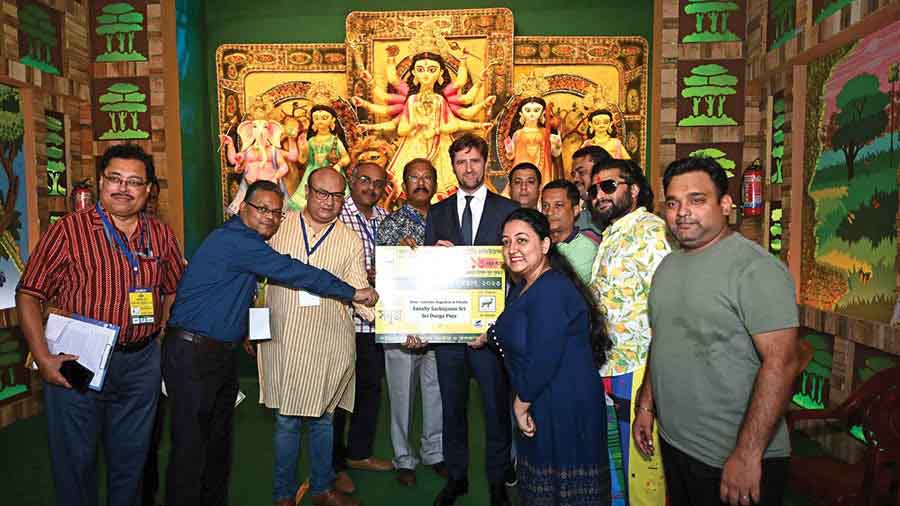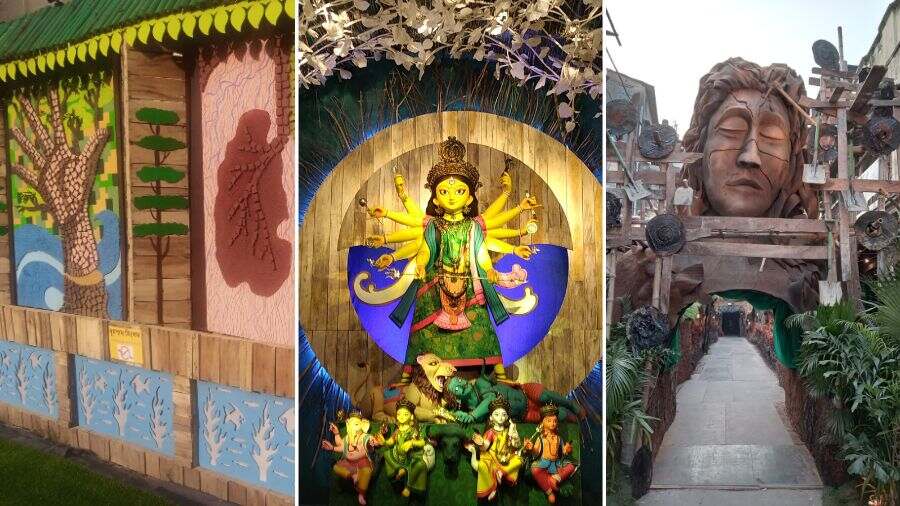The message matters as much as the idol, the decorations and the lights — the 16th edition of Serader Sera Nirmal Puja Puroskar is testament to this. Judges wrapped up the final round of the green puja awards with visits to six puja pandals on Saptami.
“We started this event in 2007 and since then we've managed to reduce energy emissions, propagate the installation of more efficient lights and helped bring an eco-friendly approach to immersion,” said Jayanta Basu, director, Environment Governed Integrated Organisation (EnGIO). Constituted by EnGIO and supported by The Bengal - Greening Bengal and Climate Action Network South Asia (CANSA), My Kolkata takes a look at some of the greenest pujos in Kolkata.
Hatkhola Gossainpara Sarbojonin Durgotsav Samity
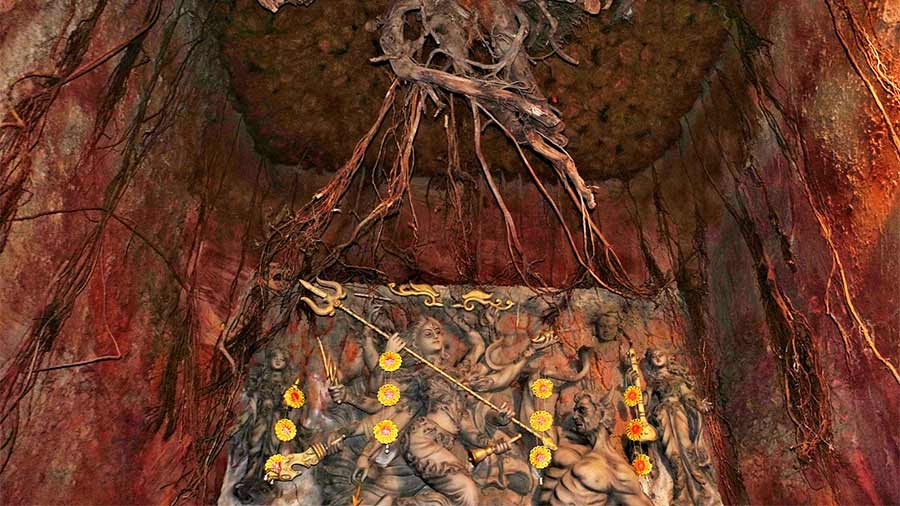
Every nook and corner of this Sovabazar pandal embodies the relationship of humans with soil, which has been steadily deteriorating because of urbanisation. The theme, Sneher Mrittika, is depicted in the exterior of the pandal through the different levels of soil, adorned by grass. The makers intended for the internal part of the pandal to represent a literal patal lok, with extensive wiring and the foundation of buildings penetrating into the soil, warning humans of the catastrophe awaiting them if they don't respect soil. Their efforts have led the jury to recognise them as the winners from the north Kolkata region.
What the judges said:
All the materials are environment-friendly, including the paint. I'm impressed to see that they have even decorated the dhaaks with artificial feathers rather than from cranes.
— Dr. Krishnajyoti Goswami, environmentalist
The theme does a great job of spreading awareness about industrialisation. The image of greenery turning into an urban jungle of buildings will stay with me.
— Dr. S.P. Gon Chaudhuri, energy adviser, Government of India
Ultadanga Bidhan Sangha

Crowned as the winners from Ultadanga-Beleghata-Talla, this pandal's theme, Du Mutho Chaal, is a reminder of urban privileges, while painting a vivid picture of life in the villages of Bengal. The pandal tells the story of how farmers toil relentlessly to feed their families. This extends to the protima, too, with Durga depicted as a mother on her way home with her children after ploughing a field all day. The organisers even planted rice fields four months ago to give an authentic feel to the pandal.
What the judges said:
This captures the essence of rural Bengal really well, something that residents of the city don't know about. I'm glad they have vividly illustrated the various phases of paddy growth.
— Naba Dutta, general secretary, Sabuj Mancha
Given the huge percentage of our population that is engaged in agriculture, this is a pertinent theme. Their depiction forces us to confront the burning problem of hunger in our country.
— Arunabha Majumdar, former director-professor, All India Institute of Hygiene and Public Health
Pally Mangal Samity

This south Kolkata pandal draws attention to the dying art of hand-painted alponas. The organisers created alponas on every wall, mirroring how families make them outside their homes on auspicious occasions. What stood out was their rhythmic and free-flowing nature. Artists from Burdwan were engaged way back in March, keeping in mind that the materials from the pandal could be handed back to them for recycling after Puja. Their innovation has landed them the top spot in the Kasba-EM Bypass-Dhakuria zone.
What the judges said:
This is a crucial call to keep our traditional culture of alpona alive, which is nowadays being replaced by stickers. Earlier, the alpona had the dual benefit of keeping homes sterile from insects, making it even more important today.
— Dr. Dhrubajyoti Chattopadhyay, vice chancellor, Sister Nivedita University
I like how both the design and the materials are organic, and it's commendable how they have involved the rural community in creating this pandal. It is aesthetic and sustainable at the same time.
— Astrid Wege, director, Goethe Institute, Kolkata
Behala Club Sarbojonin Durgotsav Committee

Centred around the post-marriage ritual of bhat kapor, this pandal hints at the women on fringes, who often have to undertake rigorous work to earn a livelihood. The regional topper from the Behala-Haridevpur zone makes a pressing case for women who work as domestic labourers and get no recognition despite shouldering all the responsibilities of a house. The choice of decorative items stand-up, comprising entirely of day-to-day items found around the house.
What the judges said:
This pandal has a beautiful way of pressing for women's empowerment with subtle nuances. The harmony in the music and day-to-day materials drive the message home.
— Andalib Elias, Bangladesh deputy high commissioner in Kolkata
There is a unique shine in their presentation, resulting from how most of their materials are very easy to obtain. The protima is simply stunning.
— Dr. Dulal Bose, professor and clinical director, Peerless Hospital
Suruchi Sangha

This Hall of Fame awardee lives up to the hype. Their theme revolves around Maa Durga's singular presence unifying all her different forms. This is a metaphor for the magic of Bengal's wide variety of art styles, all showcased in one pandal. Some of the art forms used in the pandal are patachitra from Midnapore, terracotta work from Bankura, and Chadar Badar from Birbhum. "Our first priority was using eco-friendly materials and the second was to completely avoid plastic," said Aroop Biswas, power minister, government of West Bengal.
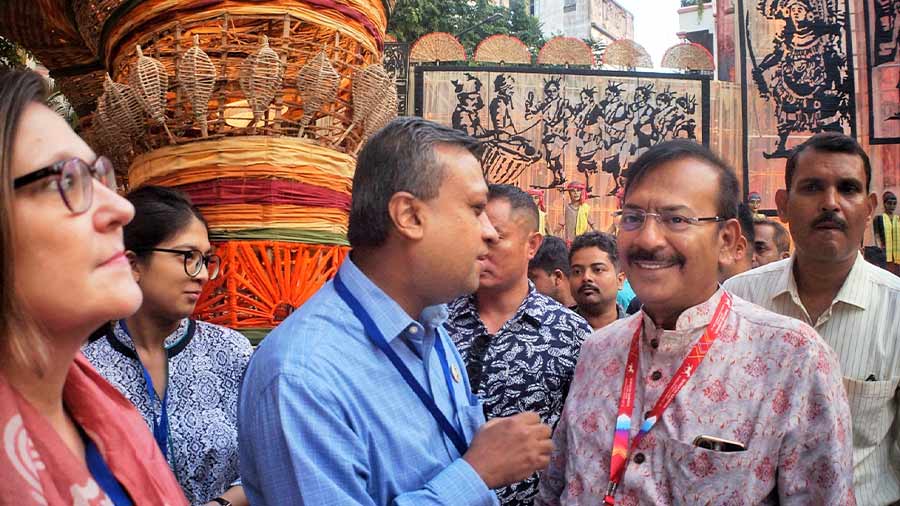
Minister Aroop Biswas greets the Green Puja judges at the Suruchi Sangha puja on Saptami
What the judges said:
I'm so glad to see all the regional arts of Bengal represented in one pandal. Everything came together as one, with sustainability at the centre.
— Dr Swati Maitra, faculty at IIT Kharagpur
This pandal is a true symbol of how colourful and ethnically diverse we are. It is a victory for Bengal.
— Dr Subhrojyoti Bhowmick, clinical director, Peerless Hospital
Shiv Mandir Sarbajanin Durgapuja
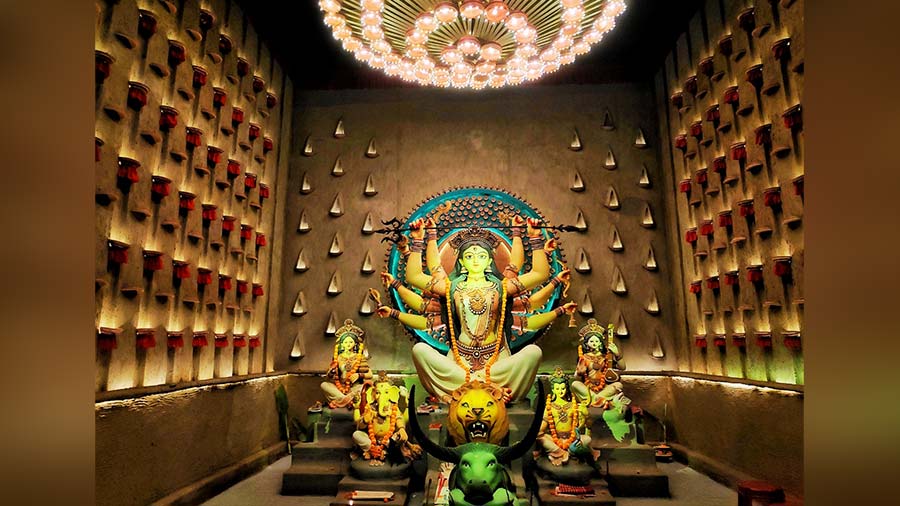
Another Hall of Fame member, this south Kolkata pujo's theme is Agol, with the pandal personifying Maa Durga's motherly embrace that makes everyone feel safe. There is a focus on sustainable materials, with most of the adornments made of clay. The organisers have tried to not let anything go to waste, with even the covers of clay pots being used to decorate the pandal.
What the judges said:
I really liked how the protective cover of clay pots signified Maa's protective hug. The parallels between a mother's protection of her offspring and Maa's protection of all humanity are endless.
— Dr. Ratna Chattopadhyay, infertility specialist
The entrance made a compelling case for looking after the neighbouring Rabindra Sarovar, and conserving its water.
— Dr. Krishnajyoti Goswami, environmentalist

